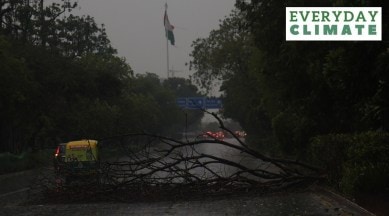For the cool summer so far, thank the frequent spells of rain
India was bracing for a record hot summer. However, western disturbances have brought some much-needed rain and surprisingly pleasant weather.

Despite a few heat waves, India has had an unusually pleasant summer so far. Temperatures in most places have been 1 to 4 degrees Celsius below normal, going against predictions of a very hot summer.
Intermittent, sometimes heavy, rain, mainly over northwest and central India, has played a role in keeping temperatures in check. Rainfall in March, April, and May has been higher than usual, and central India has been especially wet.
However, the relatively comfortable weather so far should not be considered an indication of the way things will unfold in the rest of the year. The monsoon season, which officially began on Thursday, will be critical as always.
Predictions & portents
2023 is predicted to be extremely hot both globally and in India. Indeed, the January to March period was globally the fourth warmest start to a year ever. March was the second warmest ever, behind only 2016; April was fourth warmest.
In India, there was a heat-wave like situation in February — a month for which heat-wave conditions are not even defined because heat waves are expected only in April, May, and June. April and May did indeed witness a few severe spells of heat waves in some parts of the country, and led to an incident in which 13 people died in Mumbai in April.
Despite the IMD’s forecast of a normal monsoon, apprehensions remain. The developing El Niño in the equatorial Pacific Ocean is expected to get very strong in the coming months, and has the potential to spoil India’s monsoon.
Rain and cool weather
And yet, the first five months of the year have been far from being uncomfortably hot, the few heat waves notwithstanding. Only parts of east and north-east India, and some parts of Gujarat and Maharashtra, have experienced slightly higher than normal temperatures.
The average maximums have remained well below normal almost everywhere except parts of Bihar, Jharkhand, West Bengal, and the Northeast. (Some of these areas are facing heat-wave conditions even now.)
Rajasthan, one of the hottest states in the country, has had barely 2-3 days of heat waves this season. In the first 10 and last 10 days of May, there were almost no severe heat waves anywhere in the country.
On Wednesday, Delhi recorded temperatures 8-9 degrees Celsius below normal. Many other places in northwest India were 4-6 degrees Celsius below normal, according to IMD data.
At the same time, rainfall has been higher than normal in most parts of the country. For the three-month period from March to May, India as a whole received 12% higher rainfall. Central India (Odisha, Madhya Pradesh, Gujarat, Goa, Maharashtra and Chhattisgarh) received more than twice the expected rain.
The rain has been the most important reason that has kept temperatures in check.
Western Disturbances
Most of the rainfall activity in the last three months happened over north and northwest India, and central India, and were caused by what are called Western Disturbances. These are east-moving rain-bearing wind systems that originate beyond Afghanistan and Iran, and pick up moisture from as far as the Mediterranean Sea and even the Atlantic Ocean.
These are examples of extra-tropical cyclones that are a result of low-pressure areas formed due to the interactions between polar and tropical winds. Western Disturbances frequently influence weather over India, particularly the northwestern regions.
There were seven Western Disturbance events in March, five in April, and eight in May, causing frequent, sometimes heavy, rainfall over large parts of India.
“There has been a higher number of Western Disturbances this year. We usually expect three to five events in a month,” IMD scientist R K Jenamani said.
IMD data show that 458 of the 717 districts in the country (about 64%) received higher than normal rainfall during the March-May period. Another 104 (about 15%) received normal rainfall. At this time of the year, this is very similar to the situation in 2021, but otherwise the wettest in the last five years.
A fresh Western Disturbance is expected to bring more rain to northwest India on Friday. Southern India is also expected to get rainfall over the next couple of days because of a different low-pressure system. Kerala is likely to receive some rain until Sunday, while some places in Karnataka, Andhra Pradesh and Tamil Nadu could receive rain over the next five days.
No pointer to monsoon
The current weather conditions are the result of short-term local interactions that do not have a bearing over long-term weather. How the monsoon turns out remains to be seen.
Several scientists have predicted an unusually strong El Niño this year. The IMD has said that a positive Indian Ocean Dipole (IOD), a phenomenon similar to El Niño in the Indian Ocean, could offset the impact of the El Niño to an extent. However, El Niño is known to have a much stronger impact on the monsoon than the IOD.
Monsoon is running late. On May 31, it lay below Sri Lanka in the Indian Ocean, having covered the Andaman and Nicobar Islands last week. The IMD has said conditions are favourable for the northwards advance of the monsoon over the next 2-3 days.
The monsoon usually arrives over the Kerala coast by June 1, signalling the start of the four-month season that brings about 75% of India’s annual rainfall. This year, the IMD has said the onset over Kerala is not likely before June 4.